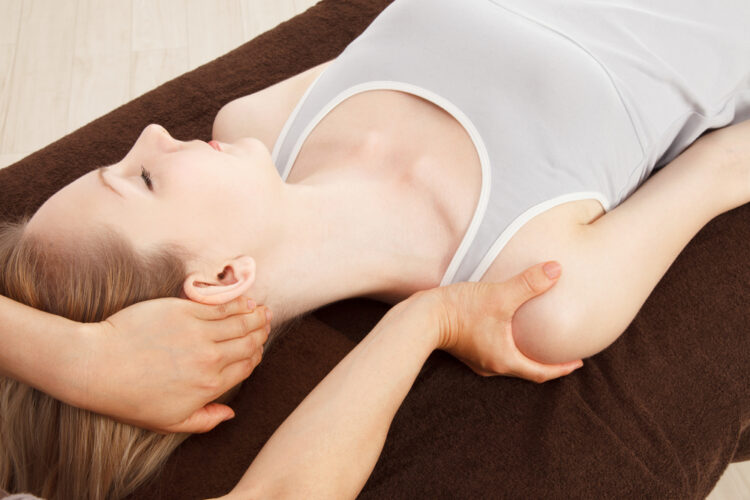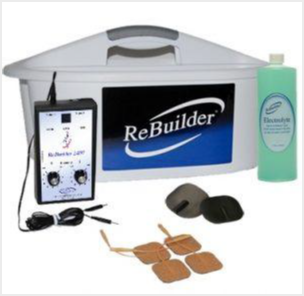
Here at Minnesota Integrative Health, we are committed to providing best-in-class patient care and treatment for patients suffering from neuropathy and other related issues. Our compassionate, experienced team of chiropractors specialize in treating nerve pain through an all-natural therapeutic approach.
Also known as peripheral neuropathy, neuropathy is a medical condition resulting from damaged or destroyed nerve cells that can cause numbness, weakness, and tingling or burning pain. Neuropathy affects the nerves of the peripheral nervous system and can be inherited or acquired through medical conditions such as diabetes, chemotherapy, kidney failure, or autoimmune diseases. When neuropathy is a side effect or caused by other medical conditions, treatment is tailored first to treat the underlying condition which then reduces the severity of the nerve pain.
The symptoms and type of neuropathy you may be suffering from largely depend on the types of nerves that are damaged. These include damaged motor nerves, sensory nerves, or autonomic nerves. With this in mind, it’s important to document what type of symptoms you may be experiencing prior to your visit to our office so we can better diagnose and treat your pain. To effectively treat the various types of neuropathy, we utilize a combination of natural therapeutic treatments such as acupuncture, corrective care, and nerve regeneration to reduce the severity of your discomfort.
We understand how unpleasant neuropathic pain is which is why we are proud to provide a comfortable, family-friendly office atmosphere for our patients. Our helpful, professional staff are here to help you manage your pain and help treat any underlying conditions.
Vibration therapy has been used since the early 1900s to improve circulation and alleviate constipation. Several years later, researchers who were using vibration therapy to improve circulation began to notice that these patients were experiencing an increase in bone density and muscle mass as well. After more research, vibration therapy was adopted by NASA and used on astronauts to improve their body’s bone density and muscle mass before and after space travel.
There are two types of vibration therapy: whole-body therapy and targeted vibration therapy. For whole-body therapy, you may be asked to sit or lay on a machine that is supported by a vibration platform. Whole-body therapy aims to reduce inflammation and help your whole body recover quicker. Targeted vibration therapy is done with a handheld treatment device that your chiropractor will use to stimulate localized areas around the body. The vibrations that are transmitted into your body cause the muscles to contract and relax.
With chiropractic care, you are working with your chiropractor to treat the underlying conditions in your body that may be causing your pain. When you combine chiropractic care with vibration therapy, we are not only able to correct the underlying conditions but also restore bone loss and help prevent symptoms from arising in the future. Using vibration therapy to supplement your chiropractic care has been shown to reduce joint and back pains, improve circulation, and reduce stress.
For more information on vibration therapy, or to schedule an appointment please, don’t hesitate to contact us at (612) 545-5672.

Neuropathy can affect both the central nervous system and the peripheral nerves in our body, though the peripheral nerves are much more commonly affected. While there is not a cure for neuropathy, there have been new developments in the treatment of nerves and nerve regeneration. The peripheral nerves have the unique ability to go through restoration if the underlying problems have been addressed. Standard medical treatments for neuropathy are built solely to manage pain. With chiropractic care, you can develop a plan to correct the underlying causes of your neuropathy, and in time, begin to regenerate your peripheral nerves.
Neuropathy gradually progressives over time. In the beginning, some patients report feeling numbness or tingling in the fingers or toes. When left untreated, the numbness begins to spread around the body and evolves into prickling pain. As the neuropathy spreads, patients begin to have issues maintaining their balance. Frequent falls do start to occur during normal daily activities for some neuropathy patients. This is when patients typically turn to chiropractic care over traditional medical treatments.
While conventional medicine serves to reduce pain, there is no plan for long-term healing or treatment of the disease. The number of neuropathy patients who are undergoing corrective chiropractic care has been growing exponentially. This is because more people are seeking alternative treatments to treat the underlying cause of their neuropathy without the risk of potential side effects from taking prescription medication.
With the proper chiropractic care, nutrition, and homeostasis in the body, our nerves are able to regenerate and heal themselves. This regeneration process may be the only way that neuropathy patients can hope to shorten their disease and find significant relief from their pain. Through chiropractic care, the goal is to release all of the tension in the body and to correct the underlying causes of your neuropathy so that the healthier the body is, the more likely the body will naturally facilitate the nerve regeneration process.
For more information on nerve regeneration, or to schedule an appointment please, don’t hesitate to contact us at (612) 545-5672.
Neuropathy is a medical condition caused by damaged nerve cells and often associated with autoimmune diseases, infections, diabetes, tumors, or hereditary conditions.
Peripheral neuropathy currently affects over 20 million people in the United States with symptoms ranging from tingling or burning pain and nausea to muscle spasms, difficulty moving your arms or legs, or atrophy.
While neuropathy can be severe, the most common forms of neuropathy include diabetic neuropathy, carpal tunnel syndrome, and sciatica which are actually quite prevalent in adult populations. The symptoms of neuropathy greatly depend on the type of nerves that are damaged, ranging from autonomic nerves, motor nerves, and sensory nerves.
Autonomic nerves control involuntary and semi-voluntary bodily functions such as bladder functions, blood pressure, heart rate, and perspiration. When autonomic nerves are affected by peripheral neuropathy, symptoms include:
Motor nerves are responsible for communicating with the brain to control muscles and movement. If peripheral neuropathy affects the motor nerves, symptoms can include:
Sensory nerves are responsible for sending messages from the rest of the body to the brain to trigger the senses. When peripheral neuropathy affects the sensory nerves, symptoms include:
Depending on the severity of your pain and symptoms, treatment for neuropathy is often adjusted to first treat the associating condition that is causing the pain. To manage nerve pain and these underlying conditions, we utilize a combination of natural therapeutic treatments such as infrared light therapy, corrective care, and nerve regeneration to greatly reduce the severity of your discomfort.

Corrective Care is a completely different approach to achieving and maintaining optimal health. A Corrective Care doctor will evaluate the Nervous System and Spine Column evaluating the person for not only trauma and pathology, but more importantly for function. Since our Central Nervous System controls all joints, tissues, organs and glands of the body, we need it to function as close to 100% as possible. When we see a patient for the first time at our office we always let them know there are two basic forms of care. One being Relief Care, which is pain control, and the other is Corrective Care, which works on the underlying structural abnormalities (correcting the cause not just treating the Symptom) to make a more permanent change. It’s likened to orthodontics.
Although all doctors are able to give relief care, the Corrective Care doctor will search for the real cause, and design a specific plan of care for each patient based on the severity of their problem, structural deviations in their spine, length of time they’ve had the problem, degeneration/arthritis in the spine, disc damage or herniation, and any pathology present in the body.
The Corrective Care adjustment and alignment process is similar to what an Orthodontist does to teeth. In time, our procedure may often correct the structural problems and spinal misalignments, thus stopping, or at least slowing down the degenerative decay in the spine (arthritis) and freeing the nerve flow. This often requires a series of visits over a period of time. It will not require bracing the spine, but instead giving very specific adjustments.
Corrective Care may aid in building a healthy body and immune system by removing the interference or blockages of nerve flow (messages) to and from the brain. We want every one of our patients to function at an optimal level, maximizing their health and quality of life, not just relieving pain temporarily.
The ReBuilder® is totally different from any other treatment system offered anywhere in the world to treat your painful symptoms of nerve pain (neuropathy).
The patented ReBuilder utilizes the latest state-of-the-art electronic technology such as machine-based learning, and the most powerful and technologically advanced Computer Processing Units (CPUs) which are the first CPUs built on nano-meter metrics. Additionally, the ReBuilder utilizes multiple bio-feedback loops that enable the device to measure and analyze the patient’s nerve function before, during, and after the treatment. This means that every 13 hundredths of a second, the ReBuilder is responding to your individual physiological status, creating, and delivering a unique signal.

Imagine if you will, that the ReBuilder acts as an ECG (electrocardiogram) to measure the heart’s function and the ReBuilder also acts as a heart pacemaker to correct dysfunction. The difference is the ReBuilder corrects dysfunction of your nerves, does both of things simultaneously and you control everything in the comfort of your own home.
What does this mean for you? It means that you are getting the very latest technology possible to restore your full mobility and relief from your symptoms. Rather than simply numbing your nerves like drugs or other TENS-like devices (essentially ineffective and potentially dangerous “toys” you can buy at Amazon or any drug store without a prescription), the ReBuilder is a full strength prescription device. The ReBuilder is able to calm down your overactive nerves and wake up your under active nerves. Additionally, the ReBuilder’s healing signals include electronic muscle stimulation which automatically strengthens nearby calf muscles (or arm muscles when used for hand pain), and increases local blood flow to enhance permanent healing.
Each 30 minute treatment is the equivalent in exercise to your legs as a 30 minute brisk walk. Because you are sitting in your easy chair at home you get the benefits of the exercise and blood flow without moving your ankles, knees, and hips, this may prove to be an important feature for those neuropathy patients suffering from joint problems.